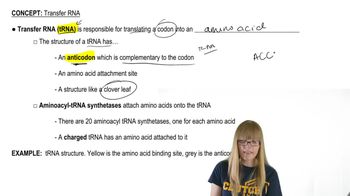Write a short essay that summarizes the key properties of the genetic code and the process by which RNA is transcribed on a DNA template.
Table of contents
- 1. Introduction to Genetics51m
- 2. Mendel's Laws of Inheritance3h 37m
- 3. Extensions to Mendelian Inheritance2h 41m
- 4. Genetic Mapping and Linkage2h 28m
- 5. Genetics of Bacteria and Viruses1h 21m
- 6. Chromosomal Variation1h 48m
- 7. DNA and Chromosome Structure56m
- 8. DNA Replication1h 10m
- 9. Mitosis and Meiosis1h 34m
- 10. Transcription1h 0m
- 11. Translation58m
- 12. Gene Regulation in Prokaryotes1h 19m
- 13. Gene Regulation in Eukaryotes44m
- 14. Genetic Control of Development44m
- 15. Genomes and Genomics1h 50m
- 16. Transposable Elements47m
- 17. Mutation, Repair, and Recombination1h 6m
- 18. Molecular Genetic Tools19m
- 19. Cancer Genetics29m
- 20. Quantitative Genetics1h 26m
- 21. Population Genetics50m
- 22. Evolutionary Genetics29m
11. Translation
The Genetic Code
Problem 5c
Textbook Question
A portion of a DNA template strand has the base sequence
5′-...ACGCGATGCGTGATGTATAGAGCT...-3′
Which is the third amino acid added to the polypeptide chain?
 Verified step by step guidance
Verified step by step guidance1
Identify the direction of the DNA template strand. The given sequence is 5′ to 3′, but transcription occurs in the 3′ to 5′ direction. Therefore, the complementary mRNA strand will be synthesized in the 5′ to 3′ direction.
Write the complementary mRNA sequence by pairing the bases of the DNA template strand. Use the base-pairing rules: Adenine (A) pairs with Uracil (U), Cytosine (C) pairs with Guanine (G), Guanine (G) pairs with Cytosine (C), and Thymine (T) pairs with Adenine (A).
Divide the mRNA sequence into codons (groups of three nucleotides) starting from the 5′ end. Each codon corresponds to one amino acid.
Use the genetic code table to determine the amino acid for each codon. Locate the third codon in the sequence and identify the corresponding amino acid.
Understand that the polypeptide chain is synthesized starting from the N-terminus to the C-terminus. The third amino acid added to the chain corresponds to the amino acid encoded by the third codon in the mRNA sequence.
 Verified video answer for a similar problem:
Verified video answer for a similar problem:This video solution was recommended by our tutors as helpful for the problem above
Video duration:
2mPlay a video:
Was this helpful?
Key Concepts
Here are the essential concepts you must grasp in order to answer the question correctly.
DNA Transcription
DNA transcription is the process by which a segment of DNA is copied into RNA by the enzyme RNA polymerase. During transcription, the DNA template strand is read in the 3' to 5' direction, and a complementary RNA strand is synthesized in the 5' to 3' direction. This process is crucial for converting genetic information stored in DNA into messenger RNA (mRNA), which carries the code for protein synthesis.
Recommended video:
Guided course

Prokaryotic Transcription
Codons and Amino Acids
Codons are sequences of three nucleotides in mRNA that correspond to specific amino acids or stop signals during protein synthesis. Each codon is translated into an amino acid by the ribosome, which reads the mRNA sequence. Understanding the genetic code, which maps codons to their respective amino acids, is essential for determining the sequence of a polypeptide chain.
Recommended video:
Translation
Translation is the process by which the sequence of codons in mRNA is decoded to synthesize a polypeptide chain. This occurs in the ribosome, where transfer RNA (tRNA) molecules bring the appropriate amino acids to the growing polypeptide based on the codon sequence. The order of amino acids in the polypeptide determines its structure and function, making translation a critical step in gene expression.
Recommended video:
Guided course

Translation initiation
Related Videos
Related Practice
Textbook Question
403
views



